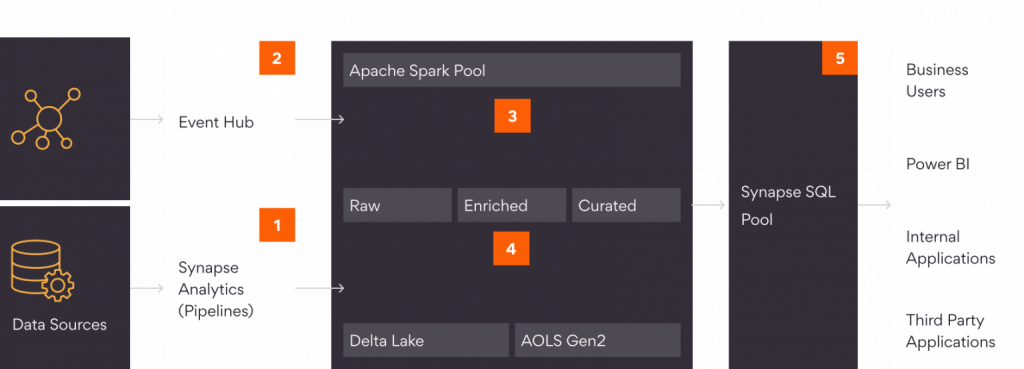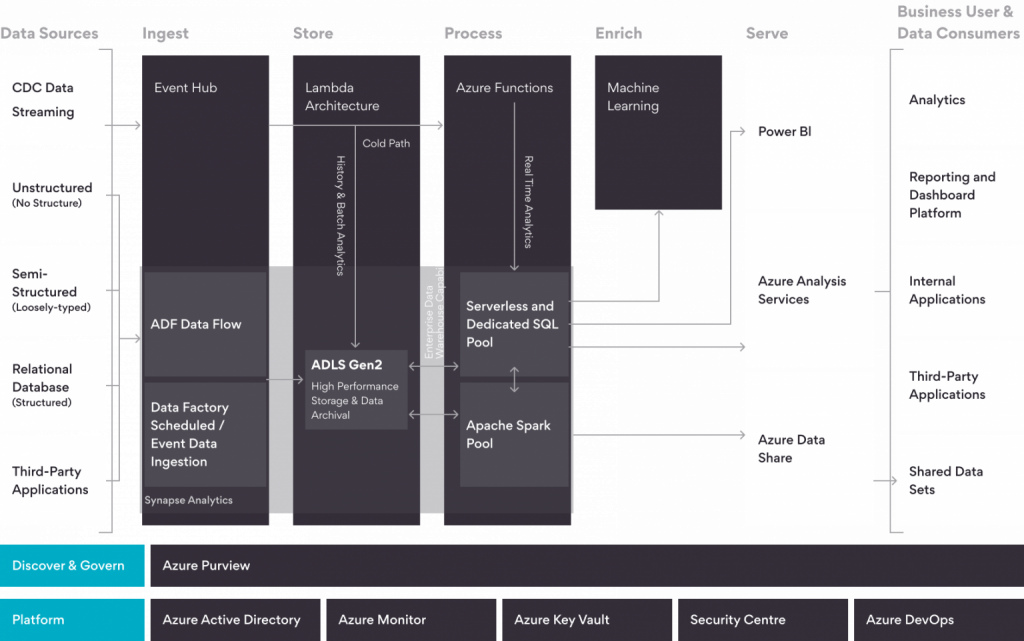Introduction:
Welcome to the era of big data, where organizations generate unprecedented volumes of data. The ability to efficiently handle large volumes of structured and unstructured data is crucial for making informed decisions and gaining valuable insights. Lakehouse architecture is one such architectural paradigm that has gained popularity.
Databricks, a company founded by the original creators of Apache Sparks, is credited with coining the term “Data Lakehouse.” Data Lakehouse was introduced to highlight the idea of a unified platform that combines data storage, data processing, and analytics in a single system.
The Lakehouse architecture combines the best of both worlds: the scalability and flexibility of a data lake and the reliability and performance of a data warehouse. Organizations can leverage the data lakehouse concept to store raw, unprocessed data in its native format while enforcing schema and conducting intricate analytics using SQL queries. To learn more about Lakehouse architecture visit https://www.databricks.com/glossary/data-lakehouse

Since its introduction, the Data Lakehouse concept has gained traction in the industry and various organizations have adopted this architecture to modernize their data infrastructure and improve their analytics capabilities. All major companies, including AWS, Azure, Google, and Snowflake, claims to support the Lakehouse architecture in their data platforms. This blog will focus on Azure and explore how it supports and facilitates the implementation of the Lakehouse architecture.
Azure Synapse Analytics and Lakehouse Architecture
Azure Synapse Analytics is a cloud-based analytics service provided by Microsoft Azure. It provides the tools to implement the lakehouse pattern on top of Azure Data Lake storage. The lakehouse architecture is a new approach that enables storing all data in one place. With native Delta Lake support in Azure Synapse, you can build different zones of the data lakehouse with Delta Lake tables. In a typical data lakehouse, the landing data zone(optional) contains the data in the native format as the source, whereas the raw, enriched, and curated zone is implemented using Delta Lake tables. A typical data flow in Synapse Analytics is shown in Fig. 2

2) Real time data ingestion via Event/lot Hubs
3) Code rich ELT via Apache Spark Pool and Low-code using ELT using data flows
4) Delta Lake based on Azure data lake store Gen2 in Raw/Enriched/Curated zones
5) Delta table exposed via Synapse Serverless SQL Pool for BI tool and Analysis
Figure 2: Data Flow in Synapse Analytics
Azure Synapse Analytics natively integrates with other services and offers features and capabilities for end-to-end analytical needs. It accelerates time to insight across data warehouses and big data systems. It combines big data and data warehousing capabilities to enable organizations to build and operate a lakehouse architecture efficiently. Let’s explore how Azure Synapse Analytics empowers organizations in various aspects of lakehouse architecture:
- Unified Data Platform: Azure Synapse Analytics provides a unified platform that integrates data ingestion, data preparation, data management, and data analytics capabilities. It allows organizations to seamlessly work with both structured and unstructured data in a single environment, eliminating the need for data movement and transformation across multiple systems.
- Scalability and Performance: Organizations can scale their lakehouse architecture based on their needs. It can manage massive data volumes, both for storage and processing ensuring high performance even with complex analytical workloads. The underlying distributed processing engine optimizes query performance, allowing organizations to derive insights from their data rapidly.
- Data Integration and Orchestration: It provides native integration with various Azure services, including Azure Data Lake Storage, Azure Data Factory, and many more. This integration enables seamless data ingestion from diverse sources, data transformation and cleansing using Azure Data Factory, and advanced analytics using Azure Databricks.
- Data Governance and Security: Organizations can enforce data governance policies and security controls across their lakehouse architecture. It offers fine-grained access control, data classification, and auditing capabilities to ensure data privacy and compliance with regulatory requirements. By leveraging Azure Purview within Azure Synapse Analytics, organizations can enhance their data governance practices, improve data quality and compliance, and enable a unified and collaborative data-driven culture. It complements the capabilities of Synapse Analytics by providing robust data discovery, cataloging, classification, and governance features across the data lakehouse architecture.
- Advance Analytics Capabilities: It supports a wide range of analytics capabilities, including SQL-based queries, serverless SQL pools, and Apache Spark-based analytics with Azure Synapse Apache Spark pools. This flexibility allows organizations to choose the right tool for the job, whether traditional SQL queries or advanced analytics using Spark.
To learn more about the Synapse centric logical Lakehouse architecture visit https://learn.microsoft.com/en-us/azure/architecture/example-scenario/analytics/secure-data-lakehouse-synapse
Microsoft-Fabric is the next generation of the lakehouse architecture and is a SaaS offering from Microsoft. It is built on Synapse Analytics and provides an end-to-end analytics solution with full-service capabilities. These capabilities include data movement, data lakes, data engineering, data integration, data science, real-time analytics, and business intelligence. All these services are backed by a shared platform that provides robust data security, governance, and compliance.

With Microsoft Fabric, your organization no longer needs to stitch together individual analytics services from multiple vendors. Instead, you can use a streamlined solution that is easy to connect, onboard, and operate. At the time of writing this blog, Microsoft Fabric is in public preview. For more details, please follow the reference links shared at the end.
Conclusion
The Lakehouse architecture, empowered by Azure Synapse Analytics, enables organizations to leverage the scalability, performance, and flexibility of a data lake with the structure and reliability of a data warehouse. With the next-generation Microsoft Fabric, organizations gain a comprehensive analytics solution that streamlines operations and ensures robust data security, governance, and compliance.
At Persistent Systems, we have extensive experience assisting clients with implementing data warehouses and data lakes, both on-premises and across various cloud platforms. As technology, frameworks, and architectures continue to evolve, we have stayed at the forefront of these advancements.
Keeping up with the latest trends in data management, we are actively engaged with numerous clients to implement lakehouse architecture by leveraging the benefits of integrating data lakes and data warehouses, combining the strengths of both paradigms.
With our in-depth understanding of the evolving data landscape, we help clients to design and implement scalable, efficient, and future-proof lakehouse solutions. Our solutions enable organizations to harness the power of diverse data sources, implement advanced analytics, and derive valuable insights to drive business growth.
Below is the reference architecture for cloud migration and data platform modernization, with Synapse analytics as the core component of the modern data platform.

This blog marks the initial segment of our multi-part series, where we delve into the topic of lakehouse architecture. In the upcoming blogs, we will continue to explore and analyze the offerings of other prominent vendors in the market.
We invite you to join us on this journey as we explore the world of lakehouse architecture and its impact on modern data management. Explore more details at https://www.persistent.com/services/data-and-analytics/data-stack-modernization/
References:
https://www.microsoft.com/en-in/microsoft-fabric
Secure a data lakehouse on Synapse – Azure Architecture Center | Microsoft Learn
https://www.databricks.com/glossary/data-lakehouse







